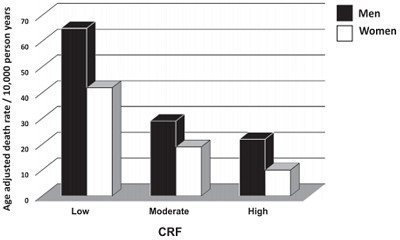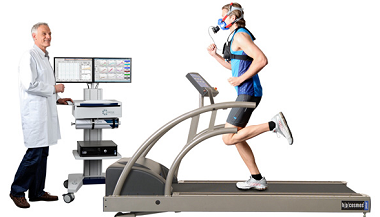Cardiorespiratory Fitness: The Key to a Longer Life
July 09 2017
If you ever thought about living longer, then this article is for you.
Why cardiorespiratory fitness (CRF)?
The AHA (American Heart Association) recently released a groundbreaking statement recommending the routine assessment of cardiorespiratory fitness (CRF) by doctors. Finally, we have compelling evidence to show that:

- Mortality: Low levels of cardiovascular fitness is associated with greater mortality and heart disease. In short, if you can improve you CRF you will live longer. The graph here shows death rate decreasing stepwise with increasing CRF
- Risk factor: It is potentially a stronger risk factor to predict mortality than established risk factors such as smoking, hypertension, high cholesterol and type 2 diabetes. In short, even if you are obese and have other risk factors, if your CRF is high you may mitigate some of the problems of obesity and smoking.
- Chronic diseases: High CRF is associated with low levels of cardiovascular diseases as well as reduced risk of Dementia, Alzheimer’s, Diabetes, other diseases. Also, associated with lower risk of developing certain cancers, including lung, breast cancer and gastrointestinal cancers
Mind you, America Heart Association (AHA) is the largest non-profit organization dedicated to fighting heart disease and stroke in the US. Most heart-related guidelines and policies you hear about come from AHA. So when AHA release official statements, you better listen
But what the heck is cardiorespiratory fitness?
Cardiorespiratory fitness means the ability or the capacity of your heart, lungs, and muscles to intake oxygen and use it to make energy. The higher your CRF, the more efficient the whole process.
- Cardio: Cardio here includes both heart and blood vessels. Just like you can make your muscles stronger by weight lifting, your heart muscles can also get stronger too. Further, your blood vessels become more elastic and less clogged with exercise.
- Respiratory:Means lungs and breathing muscles. A higher CRF means your breathing muscles are stronger, and you have more capillaries for better O2 and Co2 exchange.
- Muscles: Muscles in your body are also involved in CRF too. Higher CRF comes with more number of capillaries in the muscles (means more blood supply and better waste removal and nutrient transport) and more mitochondria (better oxygen extraction) in the muscles.
So how do you increase cardiorespiratory fitness?
- Endurance exercise: Anything that can increase your heart rate will increase your CRF. So exercises could be in the form of walking, brisk walking, jogging, playing sports, swimming, climbing stairs and such. All you need is a pair of legs!
- Low Fitness: If you think you get easily tired and may not do good, then you are in luck: The greatest benefit of CRF is seen among people who have a low level of CRF! So even 10 min/day of walking can increase CRF.
- Intensity: The greater the fitness level, harder the CF improvements and higher the intensity required. CRF is more responsive to intensity than frequency or duration. In short, if you have always been exercising, focus on walking faster or increasing your intensity of exercise.
- Strength training: Strength training, as we know, do not increase your heart rate enough to make a significant improvement in CRF.
- Diet:
All the apples, organic foods and a healthy diet will not increase your CRF.
How to measure cardiorespiratory fitness?

- Measurement: In this test known as Vo2 max/peak test, you will have to wear a mask and walk/run on a treadmill until you are basically pooped. This is the gold standard test and directly measures how much oxygen you are using. The vo2 max/peak number could range from 10 to 80 ml.o2/kg/min. Exercise science departments in most universities do provide this service for a fee
- Estimation: You can estimate your max/peak vo2 but they often comes with errors (10-15%). You can exercise at a submaximal intensity and then estimate your peak max vo2 using the heart rate obtained. For example, cycle ergometer, 1-Mile walk test, or 6 min walk test. Most fitness centers include this in their fitness assessment.
- Equation: You can also predict it solely using equations without any exercise using BMI, heart rate and so forth. Here is one: https://www.worldfitnesslevel.org/#/
As long you are using a reliable measurement, what matters is the change over time. So you do not need the gold standard to know if you CRF is improving.
Are there any Randomized controlled Trials (RCT)?
RCT’s: If you have been reading this site, you probably know that RCT’s are the gold standard in scientific studies. Currently, there aren’t any RCT’s which show a decrease in mortality and CVD with increased CRF. However, considering the strong associations and the biological mechanisms involved, these results are pretty strong, I think.
Conclusions
The official release of the statement by AHA because of the overwhelming evidence is probably the most important information to hit the exercise and fitness industry in the past decade. In fact, AHA recommends all adults to estimate or measure CRF routinely just like cholesterol and blood pressure. You can be normal weight or “in-shape”, be strong as an oak, eat healthy, or even have a six pack, but you still have a higher risk of mortality or heart disease compared to a person who is normal weight and has a higher CRF than you. People spent thousands of dollars on supplements like Vit C, Vit E, fish oils, organic foods so that they can stay healthy and live longer, but none of these have the benefits or scientific evidence anywhere remotely close to that of exercise. And it literally kills me deep down to know that this hasn’t got enough attention from fitness bloggers and news outlets; this should be the cover story for all fitness organizations and personal trainer’s sites.
- 1. in short, If you are overweight, even if you are not losing weight/fat, be aware that exercise may attenuate some of the risks of obesity via the improvement in your CRF.
- 2. If you are a trainer, please routinely measure your client’s CRF and focus on improving it than just strength and muscle/fat.
- 3. If you ever wanted to live longer, improving your cardiorespiratory fitness by exercise maybe the single most important thing you can do.
- 4. Finally, please share this with your friends and family
.
As always, Exercise Biology will bring you the most honest and cutting-edge scientific information about health and fitness that you will ever find.
Reference 1
Related Articles
| Sun October 08, 2017
Hello anoop,
Excellent article on cardiorespiratory fitness! Thank you for breaking down the research for us.
Raghu
>


